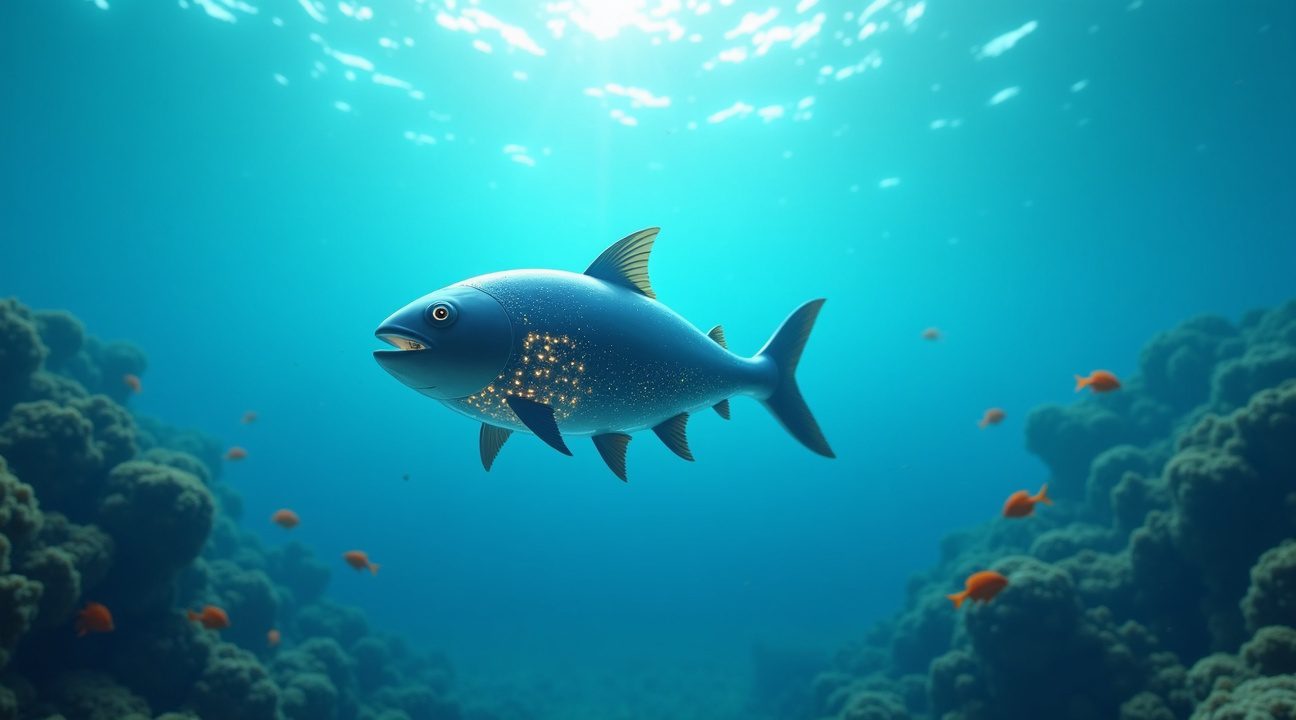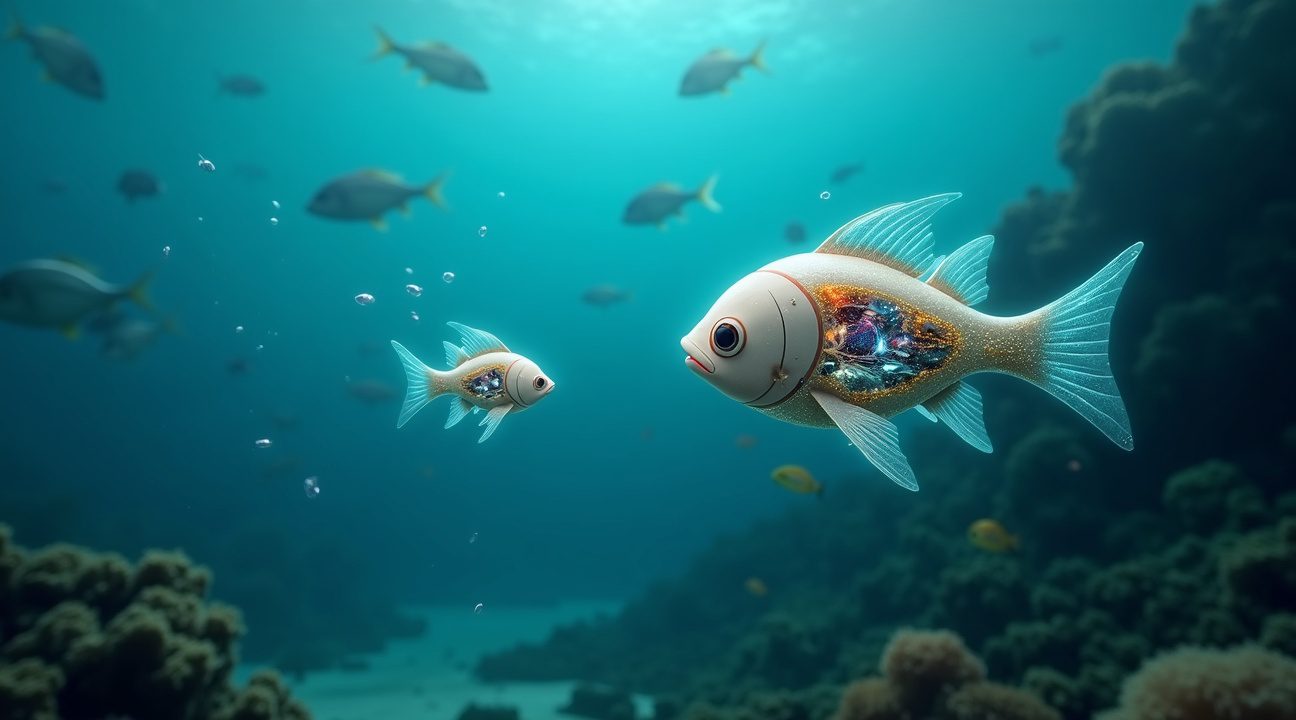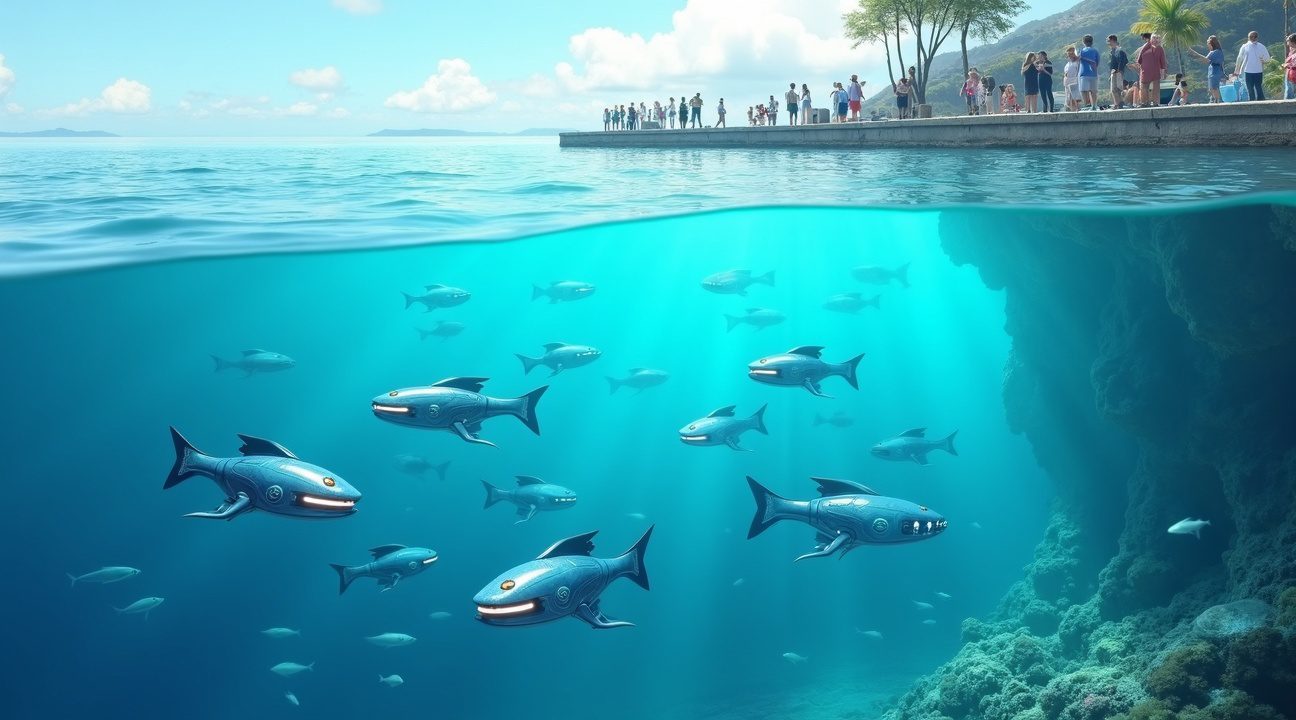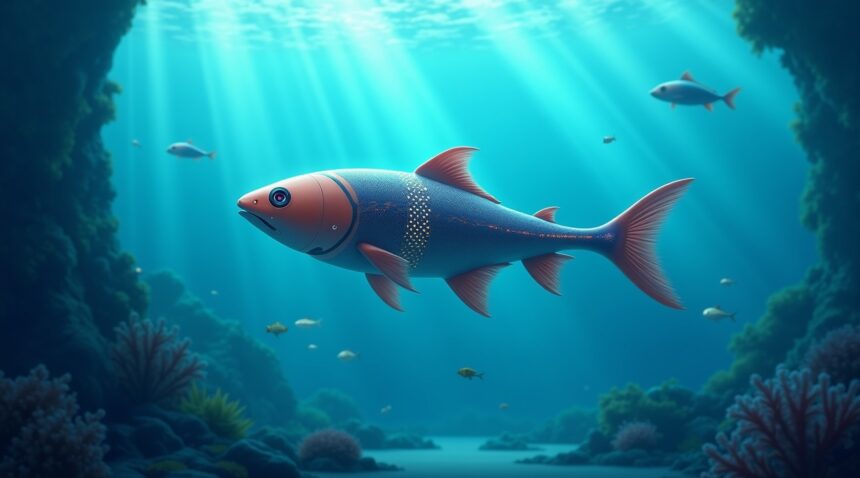The University of Surrey has unveiled Gillbert, a revolutionary robot fish engineered to tackle ocean microplastic pollution through a self-sustaining energy system that transforms collected plastic debris into electricity.
Key Takeaways
- Self-Sustaining Energy Conversion: Gillbert generates its own electricity by digesting the microplastic pollution it collects, creating a self-sustaining cleanup cycle that becomes more effective the more waste it encounters.
- Efficient Collection Capability: The robot fish can gather over 2 kilograms of microplastics during a 12-hour mission, all while maintaining continuous operation through its plastic-to-energy conversion system.
- Eco-Friendly Design: Built from biodegradable materials and sized like a salmon at 50 centimeters, Gillbert operates silently, ensuring minimal disruption to marine ecosystems. If damaged, it won’t contribute additional pollution to the ocean.
- Advanced Environmental Monitoring: Its sensor suite includes turbidity detectors, light sensors, and inertial movement units for precise environmental tracking and effective navigation in diverse ocean conditions.
- Scalable and Autonomous Deployment: Gillbert’s scalable design allows for deployment in swarms, enabling coverage across large ocean areas. This presents a cost-effective alternative to traditional cleanup strategies reliant on large vessels and constant human oversight.
This remarkable innovation originated from a contest-winning idea by an undergraduate student, showcasing the power of biomimetic design in creating real-world environmental solutions. Learn more about this pioneering research on the University of Surrey’s official page.
Student Innovation Creates Self-Powered Ocean Cleaner That Mimics Real Fish
A breakthrough in marine robotics has emerged from an unexpected source – an undergraduate chemistry student’s innovative concept has become reality. Eleanor Mackintosh from the University of Surrey submitted her revolutionary idea to the university’s Natural Robotics Contest, where it claimed the top prize and sparked the development of Gillbert, a robot fish designed to tackle one of our oceans’ most pressing challenges.
From Contest Entry to Groundbreaking Technology
The University of Surrey’s Natural Robotics Contest provided the perfect platform for Mackintosh’s visionary concept. Her winning submission outlined a biomimetic approach to addressing microplastic pollution that plagues both ocean and freshwater environments. The judges recognized the potential of her design, which promised to combine advanced robotics with environmental remediation in an unprecedented way.
Gillbert represents a significant leap forward in autonomous environmental cleanup technology. Unlike traditional cleanup methods that require external power sources or frequent maintenance, this robotic fish operates independently by consuming the very pollutants it’s designed to remove. The innovation draws inspiration from nature’s own designs, mimicking the movement and feeding patterns of actual fish while serving a crucial environmental purpose.
Targeting Microplastic Pollution at Its Source
The robot fish addresses a critical environmental challenge that affects marine ecosystems worldwide. Microplastic particles, often invisible to the naked eye, accumulate in water bodies and enter the food chain with devastating consequences. Gillbert’s design specifically targets these tiny plastic fragments, collecting and processing them through its sophisticated digestive system.
This approach offers several advantages over conventional cleanup methods:
- Continuous operation without external power requirements
- Ability to access areas difficult for larger cleanup vessels
- Selective targeting of plastic particles while avoiding marine life
- Self-sustaining operation that reduces maintenance costs
- Minimal disruption to existing marine ecosystems
The self-powered nature of Gillbert sets it apart from other robotic solutions. By converting consumed plastic into usable energy, the robot maintains its operational capacity while simultaneously removing pollutants from the water. This dual functionality creates a sustainable cycle that could revolutionize how we approach marine conservation efforts.
The development process has already attracted attention from researchers working on similar marine robotics projects. Just as scientists continue discovering new species in extreme ocean depths, innovations like Gillbert push the boundaries of what’s possible in underwater robotics. The project demonstrates how academic competitions can foster real-world solutions to environmental challenges, transforming student creativity into practical applications that benefit our planet’s waterways.
Revolutionary Energy System Turns Plastic Waste Into Robot Power
Gillbert breaks new ground in autonomous robotics by transforming the very pollution it collects into the energy needed for continued operation. This self-sustaining approach eliminates the traditional limitations that plague battery-powered underwater robots, creating a perpetual cleaning cycle that becomes more effective as ocean pollution increases.
The robot’s energy conversion system operates on a simple yet brilliant principle: the more plastic waste Gillbert encounters and collects, the more electrical power it generates for its operations. This creates an unprecedented feedback loop where environmental cleanup directly fuels the cleaning process itself. Unlike conventional underwater robots that require regular battery replacement or charging stations, Gillbert essentially feeds on the problem it’s designed to solve.
Biomimetic Design Meets Advanced Filtration Technology
Gillbert’s movement system closely replicates natural fish locomotion through sophisticated tail propulsion mechanics. This design choice isn’t merely aesthetic — it allows the robot to navigate ocean currents efficiently while maintaining the low energy consumption necessary for extended missions. The fish-like swimming pattern also helps Gillbert blend into marine environments without disturbing local ecosystems.
The robot’s collection mechanism works through an ingenious water circulation system that processes ocean water continuously during operation. Gillbert draws seawater into its internal cavity, then forces it out through specially engineered mesh gills that capture microplastic particles as small as 2 millimeters. These fine mesh filters represent a significant advancement in underwater debris collection, as they can trap particles that would typically escape larger filtration systems.
During a standard 12-hour patrol mission, Gillbert can accumulate over 2 kilograms of microplastics while generating sufficient electricity to power its continued operation. This impressive collection rate demonstrates the robot’s potential impact on large-scale ocean cleanup efforts. The autonomous surfacing capability ensures that Gillbert doesn’t become overwhelmed by its own success — when its internal storage chamber reaches capacity, sophisticated sensors trigger an automatic ascent to the surface for emptying.
The low-voltage electricity generation system represents perhaps the most innovative aspect of Gillbert’s design. Rather than relying on traditional power sources that deplete over time, this robot literally grows stronger as it encounters more pollution. This approach could revolutionize how we think about autonomous robots operating in challenging environments where conventional power sources prove impractical.
The robot’s ability to operate independently for extended periods makes it particularly valuable for monitoring and cleaning remote ocean areas where human intervention would be costly or dangerous. Research teams can deploy Gillbert in areas with high microplastic concentrations, confident that the robot will continue operating as long as pollution remains present. This self-sufficiency also reduces the carbon footprint associated with robot maintenance and support operations.
Gillbert’s success builds upon recent advances in marine robotics and environmental monitoring technology. Scientists have made remarkable discoveries about deep-sea environments that inform the development of robots capable of operating in extreme conditions. These technological foundations enable Gillbert to function effectively across various ocean depths and conditions.
The implications extend beyond immediate plastic cleanup. Gillbert’s energy system could inspire similar self-powering mechanisms in other environmental robots, potentially creating fleets of autonomous cleaners that target different types of pollution. As ocean plastic continues to accumulate at alarming rates, robots like Gillbert offer hope for scalable solutions that don’t require massive human intervention or ongoing energy inputs.
Current testing phases focus on optimizing the plastic-to-energy conversion efficiency and expanding the range of plastic types that Gillbert can process. Early results suggest that the robot performs exceptionally well in areas with high microplastic density, making it particularly suitable for deployment near coastal pollution hotspots and garbage patches. The robot’s autonomous operation capabilities mean it can work continuously in these critical areas without requiring constant human oversight.
Advanced Sensors and Biodegradable Design Keep Marine Life Safe
I find Gillbert’s 50-centimeter salmon-sized frame represents a breakthrough in marine-safe robotics. The UK researchers constructed this innovative fish from lightweight biodegradable materials that won’t harm ocean ecosystems if the device becomes separated from its operators. This thoughtful approach addresses a critical concern about introducing more synthetic materials into already polluted waters.
Sophisticated Sensor Array Enables Precise Ocean Monitoring
Gillbert’s sensor package demonstrates impressive engineering capabilities for environmental monitoring. The robot incorporates several key detection systems:
- An inertial movement unit (IMU) provides precise positioning and orientation data in ocean currents
- Turbidity sensors measure water clarity levels, helping identify pollution concentrations
- Light-level sensors enable effective night patrol operations
- Built-in lighting systems enhance visibility during dark-water missions
These sensors work together to create a comprehensive picture of marine conditions while the robot performs its plastic-consuming mission. The turbidity measurements prove particularly valuable, as murky water often indicates higher concentrations of microplastics and debris.
Remote control operation currently guides Gillbert’s movements, though future iterations may incorporate autonomous navigation systems. This technological evolution could dramatically expand deployment possibilities across vast ocean areas where human oversight becomes impractical.
The robot’s soft, biodegradable body design prevents injuries to curious marine creatures that might investigate this unusual visitor. Unlike rigid mechanical devices that pose collision risks, Gillbert’s flexible construction allows it to interact safely with fish, mammals, and other sea life. This consideration becomes crucial when operating in areas with high biodiversity or near sensitive coral reefs.
Future design improvements focus on enhanced filtration capabilities that could capture even smaller plastic particles. These refinements would allow the robot to address microplastic pollution more effectively, targeting particles that traditional cleanup methods struggle to remove. The combination of digestive energy conversion and advanced filtration creates a self-sustaining cleanup system that could operate continuously in remote ocean locations.
Similar technological advances continue emerging across marine research, from deep-sea exploration robots to sophisticated monitoring systems that track ocean health indicators. Gillbert represents a significant step forward in biomimetic robotics, where nature-inspired designs solve complex environmental challenges while maintaining ecological harmony.

How UK’s Approach Compares to Global Robot Fish Technology
The UK’s Gillbert represents a revolutionary leap beyond traditional robotic fish designs. While most international projects focus on mimicking fish appearance and movement, Gillbert takes biomimicry to an entirely new level by actually replicating biological digestive processes.
Chinese Innovation in Microplastic Collection
China’s Sichuan University has developed an impressive miniature robot fish measuring just 13mm in length. This tiny device adsorbs microplastics through electrostatic interactions rather than mechanical filtration. The Chinese robot demonstrates remarkable durability with a self-healing body structure inspired by mother-of-pearl composition. Even after sustaining damage, it maintains 89% operational efficiency, showcasing advanced materials engineering that could influence future robot designs.
Several key features distinguish the Chinese approach:
- Miniaturized scale allows access to confined water spaces
- Electrostatic collection method requires no moving filtration parts
- Self-repair capabilities extend operational lifespan
- High efficiency retention despite physical damage
Gillbert’s Digestive Advantage
The fundamental difference between Gillbert and global competitors lies in its energy generation capability. While Chinese robots and other international designs excel at collecting or adsorbing plastic waste, they remain dependent on external power sources. Gillbert actually breaks down consumed plastic through synthetic digestive processes, converting waste materials into usable energy.
This digestive approach mirrors how real fish process food, creating a self-sustaining system that becomes more efficient as it encounters more plastic pollution. Other robotic fish projects, including those exploring deep-sea applications, still require battery replacements or charging stations.
The UK’s innovation addresses a critical limitation in autonomous underwater robotics. Traditional designs face operational constraints due to power requirements, especially in remote ocean areas where maintenance proves challenging. Gillbert’s self-powered design eliminates these restrictions, enabling continuous operation in areas with heavy plastic contamination.
International robot fish projects typically focus on single functions like surveillance, data collection, or simple waste removal. Gillbert combines waste management with energy production, creating a dual-purpose solution that improves environmental conditions while maintaining its own operational capacity. This approach positions the UK at the forefront of sustainable robotics, where machines don’t just perform tasks but actively contribute to ecosystem restoration while powering themselves through the very problem they’re designed to solve.

Swarm Deployment Could Transform Ocean Cleanup Efforts Worldwide
Gillbert’s modular design positions it as a scalable solution for microplastic pollution that could revolutionize how we tackle ocean contamination. The robot’s ability to operate in coordinated groups offers unprecedented potential for large-scale environmental restoration across coastlines and busy harbors.
The deployment strategy centers on creating networks of these autonomous cleaners that can work together to cover vast areas systematically. Unlike traditional cleanup methods that require massive vessels and significant human intervention, swarms of robot fish can operate continuously with minimal oversight. This approach allows environmental agencies to target specific pollution hotspots while maintaining cost-effective operations.
Gillbert’s biodegradable construction materials represent a crucial advancement in environmental robotics. The designers understood that any cleanup technology must avoid becoming part of the pollution problem itself. Should a unit malfunction or reach the end of its operational life, it won’t contribute additional synthetic waste to marine ecosystems. This thoughtful engineering approach mirrors innovations seen in other advanced robotics where environmental impact drives design decisions.
Enhanced Capabilities for Future Ocean Monitoring
The silent operation feature addresses one of the most significant concerns with marine technology deployment. Traditional cleanup vessels create noise pollution that disrupts marine life communication and migration patterns. Gillbert’s quiet movement allows it to work alongside marine ecosystems without causing behavioral changes in fish populations or disturbing sensitive species like those found in deep ocean environments.
Future development plans focus on several key areas that will expand Gillbert’s effectiveness:
- Autonomous navigation systems that eliminate the need for remote control
- Advanced filtration capabilities for capturing even smaller microplastic particles
- Enhanced sensor arrays for real-time environmental monitoring and data collection
- Improved energy efficiency through optimized digestive processes
By filtering pollution directly at its source rather than waiting for it to disperse throughout ocean systems, Gillbert addresses contamination before it can cause widespread ecological damage. This proactive approach proves particularly valuable in areas where plastic waste enters marine environments through rivers, storm drains, and coastal activities.
The robot’s dual function as both a cleanup tool and an awareness generator can’t be understated. When deployed near populated areas, these mechanical fish serve as visible reminders of plastic pollution’s impact while actively working to solve the problem. This combination of practical action and public education creates a powerful platform for environmental advocacy.
Gillbert’s success could inspire similar innovations in other environmental challenges, much like how transportation technologies often drive broader technological advancement. The principles behind its design offer a template for developing autonomous systems that can address various forms of pollution while operating safely within natural ecosystems.

Sources:
ChapterZ Magazine: “The UK Has Created a Robot Fish That Eats Ocean Plastic”
Prince EA: “The UK Has Created a Robot Fish That Eats Ocean Plastic”
Michele Gargiulo Blog: “The Plastic-Eating Robot Fish That Feeds on Pollution to Stay Alive”
WORCON Blog: “3D Printed Robotic Fish Collects Microplastics From The UK’s Waterways”


